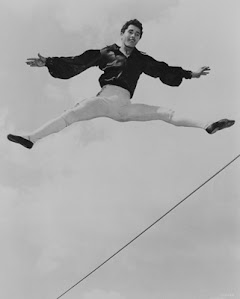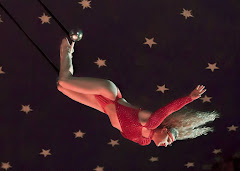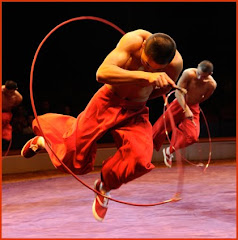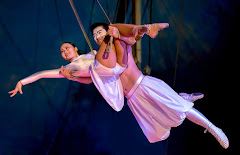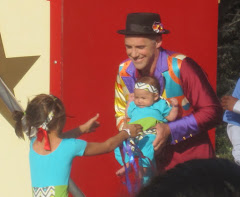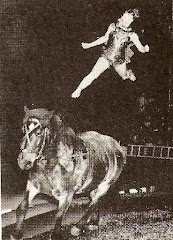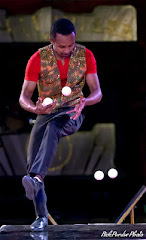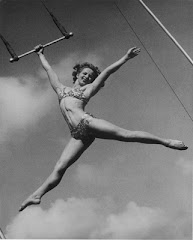Saturday, April 27, 2013
Raves to Regrets Greet Pippin’s Return to Broadway: Can Circus Save an Old Third Rate Musical in Revival?
Once again, with the return of Pippin to Broadway, the issue of circus merging with “theatre” (quality notwithstanding) captures my skeptical attention. Recent efforts along the Great White Way to incorporate acrobatics and aerial stunts in singing and dancing shows began with the abysmally panned Banana Shpeel from a then smugly over-confident Cirque du Soleil. Then came Spiderman, which utilizes rigging to facilitate flight sequences (really not a circus musical at all but something more like Peter Pan) – it is doing well. After that, Cirque’s thematically reaching (if not mind-grinding) Zarkana, built to last at Radio City Music Hall for ten summers (some critics loved the acts, but were left yawning over the Zazrkana’s obtuse theatrical allusions), but last it did not, not beyond two mediocre seasons.
And now, Pippin’s campaign to repeat its winning box office of 1972, that original staging largely dismissed by the critics for a stupidly naive book. I had the misfortune of paying for a ticket to the show near the end of its run, and I sat there wondering, can Broadway really be this bad? One of the worst musicals I’d ever seen.
But now, instead of a band of hippie gypsies dancing up a Bob Fosse storm to save the world, flower power style, this new Pippin gives us a tent full of circus performers, directed by Gypsy Snyder (from the original Pickle Family Circus), and now, as was the case with Zarkana, they’re talking up the great circus elements. And they’re — some of them — talking down a hackneyed libretto nearly buried alive under the big top trimmings. Some say the dancers can't compare to the tumblers. Go, circus!
To be sure, this Pippin has won some raves, among them USA declaring it “the best musical of the season.” The doubters focus on our central issue — the usually troubling combination of circus and stage, and how mildly frustrating, despite sawdust thrills, that it can be to sit through.
Ben Brantley in the New York Times more or less echoed a similar ambivalence from theatre critic Terry Teachout in the Wall Street Journal, the latter summing up: “On occasion, there’s fun to be had from this Pippin ... But I went home feeling as though I’d been yelled at for 2-1/2 hours.”
The better reviews promise a rich world of visual entertainment. The intriguing question, particular to this show, may be: Will the Times Square consumers, who tend to reach the ticket windows with theatre mind sets, really wish to spend an evening inside a Broadway playhouse watching circus acts? They apparently did not at the Radio City Music Hall. And they most certainly did not at the Kodak Theatre in Hollywood.
This will be an interesting story to follow. If we are to believe the raves, maybe, just maybe they’ve at last merged circus and “theatre” in a way that will capture the public's fancy and keep the ticket windows humming for a long long time. The best Broadway revivals rarely last more than a couple of seasons. Pippin could prove itself worthy of that mark, exceed it, or (my guess) slowly but surely peter out under the weight of its overwrought irrelevance to a neighborhood not friendly to Barnum & Bailey — even to the sainted Cirque du Soleil.
Sunday, April 21, 2013
So Long, Salnatra ... Hope You're Singing Round the Moon
Good friend Salvatore Dieli
We were ambling up Colorado Boulevard in Pasadena, having just finished a feastly meal. Sal was feeling pretty good, better than average that day. I had met him and Judy at Union Station, where we had hopped the Gold Line.
A few blocks on, looking for a coffee sit down, Sal snapped into song, and in moments he was Salnatra (my nickname), singing his old standby - Fly Me to The Moon! Being a retro punk in a Frank stance, his pipes blowing out the musty dusty notes of a long hibernation produced by too many ills. Maybe too many pills. And again, Sal was back in full swing. He had the beat, the pulse, the rusty polish, the ATTITUDE ... Strangers in the Night! ... I’ve Got You Under My skin!
Judy and I exchanged victorious glances. The guy was alive again.
Alas, for one last moment before a long slow sleep, getting ready, it seemed, to face the final darkness.
The year was around 2007.
Sal crooning in a Carlsbad, CA karaoke
Slowly, Sal lost his will, tossed and torn by inner demons. The still resilient Judy moved herself and Sal up to Santa Rosa, where, refusing to settle for institutional gloom, she found for Sal a nice cozy home of assisted care. He had his own small bedroom. There, peacefully he settled in under a heavy cloud of detachment. Whenever I went out with Judy to visit, I’d find him on the bed, sleeping or wanting to sleep, sometimes having to be wrested into a sitting position. Feebly, he’d host us. Sometimes we’d talk for a little bit, and he might become animated, gifting me with a hint of the Sal he no longer could be. Once or twice, I got him to sing a few lines or two, and he felt good about it. Sometimes when the mood (or the right medication) hit him, Sal, from what a charmed staff reported to Judy, would saunter about the place giving concerts. And then he'd crash, back onto a morose bed of resignation.
Steadily, as if preplanned, Sal lost his will almost completely. He was in the hands of doctors and drugs and medicare red tape, endlessly for Judy. She’d visit Sal almost everyday.
And then, on St. Patrick’s Day, following more hospital and rehab runs and doctors issuing conflicting prescription orders, on and off, then on again, Sal finally silenced into his last sleep.
When Judy notified me in a phone message, I felt a wonderful relief. So had Judy.
This was a guy who had served his country for 20 years as a medic while stationed in China, Korea, and Guam, among other places. A guy who had taken up tennis at age 50, had taught driver ed in Los Angeles schools for 15 years, had boxed, had coached a boxing team for the USAF all the way to France. Had taken up photography. And had enjoyed public validation singing in many piano bars.
For me, a long oppressive cloud had been lifted, such that I was able to find a way back to the face of Sal, the soul and smile of Sal, the life of Sal ... the Sal so full of song, humor and attitude.
Welcome back, Salnatra!
The three of us in the best of times
Thursday, April 18, 2013
Paging the Japanese Circus Artists: Where in the World Are You? Are You Anywhere in the World?
Billed for his "Suicidal Pursuits On A Steeply Sloping Strand,"
slide wire star Takeo Usui, with Ringling-Barnum,1955
slide wire star Takeo Usui, with Ringling-Barnum,1955
photo by Sverre Braathen, used with permission from Illinois State University’s
Special Collections, Milner Library
A new book out, which looks to contain significant scholarship, should, as a byproduct, remind us that once upon a season, great jugglers, acrobats, wire walkers and other sawdust wizards came to us from Japan.
No longer, and I am suddenly asking myself, WHY?
What in the friggen world ever happened to you? Did you take your stellar aristy to another planet? Sell out to the Cirque King and hide behind his worn out masks? Get suffocated to death under all that dry ice?
Consider this most deflating measurement of the Japanese circus artist. From Monte Carlo, yes -- attention, please! From Monte Carlo, a list of various countries that have earned Gold Clowns at its annual festival contains, in total for Japanese artists, 0. Shall I spell (or misspell) it out? ZERO. Nyet. Nothing. Perhaps some silvers or coppers, they are not listed.
Was it simply, here Showbiz David is putting his best brainpower to work, a matter of the advancing Japanese trading in their acrobatic skills for technology careers?
There is a new book out, Professor Risely and the Imperial Japanese Troupe: How an American Acrobat Introduced Circus to Japan --- and Japan to the West.
This is not a book review. I have not seen it, but I congratulate its author, Frederick L. Schodt, for having undertaken the research and time, and I hope he sells many copies.
In essence, in 1866, Risley assembled 18 top flight Japanese acrobats, named them The Imperial Japanese Troupe, obtained Japan's first civilian passports for its members, and brought them to the States, opening in my home town of San Francisco. (No, I wasn't there to review the show, sorry.)
Their arrival in the City by the Bay marked the first time in two hundred years that Japanese had been allowed beyond their coastal waters. They were generally referred to as jugglers.
They saw much of the city, and it seems the city could not get enough of them. They rode in carriages out through the sand dunes of western San Francisco (I was raised in that area) to the Cliff House and Seal Rocks, and marveled at California sea lions.
They gave their first performance on January 7 at Maguire's Academy of Music for a three-day run. A huge success. Seats were jammed to overflowing. Doors were locked shut. Acts worked on ladders, tubs, bamboo poles, and many of the best jugglers were female.
Perhaps the troupe's biggest hit was a young very showmanly lad named Umekichi, who took on the name "Little All Right." Noted a New York Times writer, "The ladies will faint and the men go crazy over a juvenile performer whom we have called 'All-Right.'" He was such a sensation working the crowd that at the completion of Little All Right's "perilous ladder feat," the audience stormed the stage with "half dollars, five, ten, and twenty dollar gold pieces."
The clever little guy shouted back, "All right, you bet!" which spirited another rainfall of coin.
In New York the following May, the same raving reception greeted the Japanese, extending their run by nearly two months, producing turn-away crowds at many shows.
I could go on. My source is an excerpt from the book published in The Bandwagon, thanks to Bandwagon's on-again, off-again editor Fred D. Pfening III. Harper's Weekly gave the troupe prime coverage, spoofing, seen above, the effect it had on the moppets - "The children have been to see the Japanese." Harper's helped seal the troupe's fame, finding in it valid and flattering evidence of the land from which it came. They "reveal to us a phase of the interior life of Japan which can not be otherwise gained in this country, and which no one should miss seeing."
Japanese artists eventually became significant contributors to our American shows: Quoting from the Ringling Bros. Route Book for 1892, in its listing of displays:
The Mikado's Troupe of Royal Japanese from the city of Yedo
Whose feats invade the realm of the impossible.
S. Qura, Manager. Ando Hamakichi, Akimoto,
Tan Zabaro, Toyou Kichi, Sam Kichi, Miss Quome, Miss Okee
Sigh. Out there surfing the internet of today, I find a troupe called Kinoshita Circus that tours Japan, and it apparently offers a wide-ranging mix of international circus acts and animals, and even Ringling-trained clowns. It does claim to include "traditional Japanese acrobats."
Perhaps not all is lost, but as for the bigger picture, you be the judge. At Monte Carlo, as of a few years ago, here was the total Gold count:
Russia 11
China 11
North Korea 10
United States 4
France 3
and so on down the line, country to country to
Hungary: 1
Japan was nowhere on the list. Maybe their acrobats have all fled to North Korea.
Members of the Yueno Troupe added choreography and atmosphere to Ringling-Barnum production numbers in 1955
Photo by Sverre O. Braathen, used with permission from Illinois State University’s Special Collections, Milner Library [black and white sketches from Bandwagon]
Sunday, April 14, 2013
Sunday Morning with Don Marcks: My Elephant Hair Extractions While Clowning on Wallace Bros.
Ha! This almost sounds like a Steve Copeland post. Me, collecting elephant hairs? It must have happened, if we are to believe Don thanking me in a letter dated October 3, 1961, after my six weeks trying to be a trouper (clown) for Wallace Bros. Circus.
Reading back through Don's letters, am I glad I've saved them all, actually at one point close to tossing some of them away. Yes, what wretched dis-appreciation for my OWN history, as well as DON'S.
When you look back over your own archives, you discover things you had totally forgotten, giving you reasons for actions taken that you have since misrepresented to yourself.
"Many thanks for the elephant hairs and the data on the Wallace Circus elephants which you sent me," Don wrote, and how surprised I was to read it this evening. How strange, the things we forget. Which gives these letters, however simple, such richness. In some, feelings of those days in my youth return. Don was a great friend, especially considering my sometimes overbearing opinionated ways, having been sent over the moon by the White Tops when they published me at age 14. I think, in some quarters, they are still regretting it.
Continuing, "I was quite surprised and happy to receive them, for I never dreamed that you would actually be able to get the hairs."
Which make me happy I did -- however I brought it off. I'm not the type to wiggle between a mammoths legs with scissors in hand.
"I figured that if we could gather the information on them we'd be pretty lucky. Many thanks for all of the work you did for me here I certainly do appreciate it."
We circus fans each have different areas of intense interest. Some the band. Some the tents, the wagons. Some the pachyderms.
Next week: More from Don's letter - about his thoughts on my having traveled with Wallace Bros. and about the Ringling show that year. Also, as a bonus to a certain crowd, I'll see if I can dig up some mud. Cool?
Wednesday, April 10, 2013
Big Top Battered by Bullets for Elephants ... Shriners Ban Peanuts for a Night ...
Come on in, shovel up a little sawdust and have yourself a half laugh or 2, on me.
Some recent giggles from the PC front: Out, damn nuts! You’re allergic to them, too, you say? You should a gone to the opening performance last March 28 of the Yelduz Shrine Circus, where peanut peddling took a hit — banned for the night. Popcorn and candy bars, peanut free too.
Not so funny: This is strange. “Bullets by the big top” announced a local NBC TV reporter. Target practice from a freeway aimed at a Ringling elephant in Tupelo, Miss. Motive not known. What next at the front door, TSA agents patting down kids in clown face? “Crazy” said the reporter, reporting an award of $21,000 for anybody who can identify the gunman. And this, in a raging red state? Animal expected to make a full recovery. And for that, I'd say, give the mammoth a bucket of old fashioned you-know-what. Peterson Peanuts, here's your big PR moment. Get cracking!
Staying nutty, here are some things I’d like to see banned, if only for one-performance per date, to be vividly pitched in advance. I'd buy front row seats, I would.
1. Hula hoops
2. Motor bikes up inclined wires
3. Solo confusion on the fabrics
4. hula hoops bearing international awards
5. Peanut pitches
6. clown participation acts
7. A “live band” consisting of an organist and records.
8. hula hoop participation acts
Some recent giggles from the PC front: Out, damn nuts! You’re allergic to them, too, you say? You should a gone to the opening performance last March 28 of the Yelduz Shrine Circus, where peanut peddling took a hit — banned for the night. Popcorn and candy bars, peanut free too.
Not so funny: This is strange. “Bullets by the big top” announced a local NBC TV reporter. Target practice from a freeway aimed at a Ringling elephant in Tupelo, Miss. Motive not known. What next at the front door, TSA agents patting down kids in clown face? “Crazy” said the reporter, reporting an award of $21,000 for anybody who can identify the gunman. And this, in a raging red state? Animal expected to make a full recovery. And for that, I'd say, give the mammoth a bucket of old fashioned you-know-what. Peterson Peanuts, here's your big PR moment. Get cracking!
Staying nutty, here are some things I’d like to see banned, if only for one-performance per date, to be vividly pitched in advance. I'd buy front row seats, I would.
1. Hula hoops
2. Motor bikes up inclined wires
3. Solo confusion on the fabrics
4. hula hoops bearing international awards
5. Peanut pitches
6. clown participation acts
7. A “live band” consisting of an organist and records.
8. hula hoop participation acts
Thursday, April 04, 2013
UPDATE: GIBSONTON RESPONDS! This Was Once a Foley & Burke Flat Car, Before the Circus World Museum Shamefully Defaced its True Identity
UPDATE TO POST, 7/22/13: I was delighted to receive a new comment left on this post by "Doc" Rivera, curator of the International Independent Showmen's Museum in Gibsonton, Florida. For those interested, please link onto comments below.
Warning to those considering an artifact donation to Circus World Museum. It could end up tossed aside into anonymous dust. It could be walked off with by an employee seeking to enrich his or her personal collection. It could be defaced beyond recognition. Worse yet, converted into something other than what it is. In other words, rather than preserved under ideal museum conditions, your donation might be virtually lost forever.
Exhibit A: the above photo of a Foley & Burk flat car shipped to Circus World in 1971 by the late carnival owner Lloyd Hilliogsss. This flat car, to the common eye, no longer exists. Sometime around the year 1985, Mr Hilligoss's offering vanished completely out of sight, off the lot -- into the abyss of shameful museum meddling to feed its obsession for more wagons, more car train cars. More more more no matter how bogus or how little of the original materials actually exist.
A Shameful Neglect of Carnival Items Offered in Good Faith
"Foley & Burk" was removed from the flat car, to be replaced by the words "Ringling Bros. and Barnum & Bailey."
Does anybody out there need more persuasive evidence that, at Circus World, traditional museum preservation ethics are trumped and trashed at the whim of reckless personal agendas? No wonder Circus World (as it now calls itself) was kicked out of the American Alliance of Museums back around 1999. Perhaps that was why the powers that be decided to delete the word "museum" from the founding title.
Walking the grounds, you may find some old F&B wagons out there in the open air. The circus wagons? They enjoy tony indoor quarters, possibly temperature controlled to protect and preserve their alleged authenticity. I know one insider who refers to the formidable collection as "the world's largest full-scale model circus wagon exhibit."
Among the standards of conduct that must be adhered to by members of the museum association, one is that a collection must be made reasonably accessible to the public. Among the elements of acceptable “Collections Stewardship” specified by the association, there is this: “The museum provides public access to its collections while ensuring their preservation.”
The Tale of the Thimble Theatre Fun House
I was once informed by a previous library director that, in fact, the Foley & Burk Thimble Theatre fun house was at one time erected, but that it was too dangerous for people to walk through. This rationale for its being confined, off site, to a shoddy wall-less barn, subjected to the harsh winter elements, was at the least disingenuous. Since when does a historical fun house have to be fully operational in order for it merely to be set up and displayed? Since when, for that matter, do museum officials allow the public to climb aboard and walk through any of their coveted "circus wagons"?
For Those Fans Who Care
This Foley and Burk photo, posted on Bob Cline's blog, Sawdust and Spangles, on August 4, 2010, was brought to my attention by an interested party, the latest in a series of interested parties who discover my posting about the history of Circus World (to find the posting: type "A Tale of Two Museums in the search box above), and, as a result, will e-mail me to share their own regrets and frustrations. This person has contacted Baraboo, and also operatives at the Wisconsin State Historical Society, who technically own the entire Circus World, down to every last book and bolt. What might be done, he asked each, for the fun house and other F&B wagons to be properly displayed? To be handed over to a more appropriate facility for professional preservation? The answers he received were evasively bureaucratic. Can it be a secret to anybody that the folks who make a living at Circus World are driven to raise money so that they can preserve their jobs, period?
Wrote Bob Cline on his post:
"Here's one of those rare, once in a lifetime shots of the Foley and Burk wagons and flatcar after they arrived at the Circus World Museum. They kept the Foley and Burk title on the flatcar for the first year they used it in 1972. They did change the number from Foley and Burk's #45 to the CWM #75. It remained the same for the 1973 parade.
By time they resurrected the train again in 1985, this car was now painted silver with the red letters and white outline using the classic Ringling Bros. and Barnum and Bailey Combined Circus title."
Anybody out there care to challenge or correct my thinking? Am I getting it all wrong? Do I fail to understand some deeper essence?
A Better Home at the Right Musuem
There are, it appears, the makings of a fine carnival museum down in Gibsonton, Florida (seen in the above renderings), to be known as the Museum of the American Carnival, spearheaded by the International Independent Showman's Association. This would involve the University of South Florida. I have written to them, asking if theoretically, they might be happy to take custody of the Thimble Theatre and other Foley and Burk items, should Circus World come to the plate and offer them for a transfer. If I hear back, I will report it on this blog.
Here, from their website:
"The Museum of the American Carnival has been a dream held by historians, carnival enthusiasts, and those in the outdoor amusement business for the past decade. With the generous support of the International Independent Showmen's Museum Corporation, Greater Sun City Center Community Foundation, International Independent Showmen's Association, members of the International Independent Showmen's Association, and University of South Florida Libraries Special Collections Department, the museum is near completion. The museum currently features historical wagons from various carnivals and traveling shows, several rides, rare games, photographs, and other carnival related artifacts."
Circus World Museum -- and/or Wisconsin Historical Society: Are you reading this? Have you a conscience? Or have you no shame?
Link onto "Doc" Rivera's comment below.
4.4.2013
Subscribe to:
Posts (Atom)















